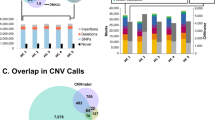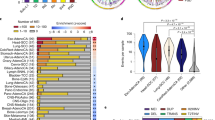Abstract
We have used large-scale insertional mutagenesis to identify functional landmarks relevant to cancer in the recently completed mouse genome sequence. We infected Cdkn2a−/− mice with Moloney murine leukemia virus (MoMuLV) to screen for loci that can participate in tumorigenesis in collaboration with loss of the Cdkn2a-encoded tumor suppressors p16INK4a and p19ARF. Insertional mutagenesis by the latent retrovirus was synergistic with loss of Cdkn2a expression, as indicated by a marked acceleration in the development of both myeloid and lymphoid tumors. We isolated 747 unique sequences flanking retroviral integration sites and mapped them against the mouse genome sequence databases from Celera and Ensembl. In addition to 17 insertions targeting gene loci known to be cancer-related, we identified a total of 37 new common insertion sites (CISs), of which 8 encode components of signaling pathways that are involved in cancer. The effectiveness of large-scale insertional mutagenesis in a sensitized genetic background is demonstrated by the preference for activation of MAP kinase signaling, collaborating with Cdkn2a loss in generating the lymphoid and myeloid tumors. Collectively, our results show that large-scale retroviral insertional mutagenesis in genetically predisposed mice is useful both as a system for identifying genes underlying cancer and as a genetic framework for the assignment of such genes to specific oncogenic pathways.
This is a preview of subscription content, access via your institution
Access options
Subscribe to this journal
Receive 12 print issues and online access
$209.00 per year
only $17.42 per issue
Buy this article
- Purchase on Springer Link
- Instant access to full article PDF
Prices may be subject to local taxes which are calculated during checkout



Similar content being viewed by others
References
Sherr, C.J. The Cdkn2a network in tumour suppression. Nature Rev. Mol. Cell Biol. 2, 731–737 (2001).
Ruas, M. & Peters, G. The p16INK4a/CDKN2A tumor suppressor and its relatives. Biochim. Biophys. Acta 1378, F115–177 (1998).
Serrano, M. et al. Role of the INK4a locus in tumor suppression and cell mortality. Cell 85, 27–37 (1996).
Jacobs, J.J., Kieboom, K., Marino, S., DePinho, R.A. & van Lohuizen, M. The oncogene and Polycomb-group gene bmi-1 regulates cell proliferation and senescence through the ink4a locus. Nature 397, 164–168 (1999).
Inoue, K., Roussel, M.F. & Sherr, C.J. Induction of ARF tumor suppressor gene expression and cell cycle arrest by transcription factor DMP1. Proc. Natl Acad. Sci. USA 96, 3993–3998 (1999).
Bates, S. et al. p14ARF links the tumour suppressors RB and p53. Nature 395, 124–125 (1998).
Ohtani, N. et al. Opposing effects of Ets and Id proteins on p16INK4a expression during cellular senescence. Nature 409, 1067–1070 (2001).
Passegue, E. & Wagner, E.F. JunB suppresses cell proliferation by transcriptional activation of p16(INK4a) expression. EMBO J. 19, 2969–2979 (2000).
Zindy, F. et al. Myc signaling via the ARF tumor suppressor regulates p53-dependent apoptosis and immortalization. Genes Dev. 12, 2424–2433 (1998).
Jacobs, J.J. et al. Senescence bypass screen identifies TBX2, which represses Cdkn2a (p19(ARF)) and is amplified in a subset of human breast cancers. Nature Genet. 26, 291–299 (2000).
Damalas, A., Kahan, S., Shtutma -dependent growth arrest and cooperates with Ras in transformation. EMBO J. 20, 4912–4922 (2001).
Zhu, J., Woods, D., McMahon, M. & Bishop, J.M. Senescence of human fibroblasts induced by oncogenic Raf. Genes Dev. 12, 2997–3007 (1998).
Radfar, A., Unnikrishnan, I., Lee, H.W., DePinho, R.A. & Rosenberg, N. p19(Arf) induces p53-dependent apoptosis during abelson virus-mediated pre-B cell transformation. Proc. Natl Acad. Sci. USA 95, 13194–13199 (1998).
Lin, A.W. et al. Premature senescence involving p53 and p16 is activated in response to constitutive MEK/MAPK mitogenic signaling. Genes Dev. 12, 3008–3019 (1998).
Serrano, M., Lin, A.W., McCurrach, M.E., Beach, D. & Lowe, S.W. Oncogenic ras provokes premature cell senescence associated with accumulation of p53 and p16INK4a. Cell 88, 593–602 (1997).
Jonkers, J. & Berns, A. Retroviral insertional mutagenesis as a strategy to identify cancer genes. Biochim. Biophys. Acta. 1287, 29–57 (1996).
Radhika, V. & Dhanasekaran, N. Transforming G proteins. Oncogene 20, 1607–1614 (2001).
Bjorge, J.D., Jakymiw, A. & Fujita, D.J. Selected glimpses into the activation and function of Src kinase. Oncogene 19, 5620–5035 (2000).
Ishibashi, T., Bottaro, D.P., Michieli, P., Kelley, C.A. & Aaronson, S.A. A novel dual specificity phosphatase induced by serum stimulation and heat shock. J. Biol. Chem. 269, 29897–29902 (1994).
Aguirre Ghiso, J.A., Kovalski, K. & Ossowski, L. Tumor dormancy induced by downregulation of urokinase receptor in human carcinoma involves integrin and MAPK signaling. J. Cell Biol. 147, 89–104 (1999).
Joyce, D. et al. NF-κB and cell-cycle regulation: the cyclin connection. Cytokine Growth Factor Rev. 12, 73–90 (2001).
Borrow, J. et al. The translocation t(8;16)(p11;p13) of acute myeloid leukaemia fuses a putative acetyltransferase to the CREB-binding protein. Nature Genet. 14, 33–41 (1996).
Li, Q.-L. et al. Causal relationship between the loss of RUNX3 expression and gastric cancer. Cell 109, 113–124 (2002).
Comijn, J. et al. The two-handed E box binding zinc finger protein SIP1 downregulates E-cadherin and induces invasion. Mol. Cell 7, 1267–1278 (2001).
Jacobs, J.J. et al. Bmi-1 collaborates with c-Myc in tumorigenesis by inhibiting c-Myc-induced apoptosis via Cdkn2a. Genes Dev. 13, 2678–2690 (1999).
Patriotis, C., Makris, A., Chernoff, J. & Tsichlis, P.N. Tpl-2 acts in concert with Ras and Raf-1 to activate mitogen-activated protein kinase Proc. Natl Acad. Sci. USA 91, 9755–9759 (1994).
Suzuki, T. et al. New genes involved in cancer identified by retroviral tagging. Nature Genet. 32 86–94 (2002).
Mikkers, H. et al. High-throughput retroviral tagging to identify components of specific signaling pathways in cancer. Nature Genet. 32 73–79 (2002).
Roth, P., Dominguez, M.G. & Stanley, E.R. The effects of colony-stimulating factor-1 on the distribution of mononuclear phagocytes in the developing osteopetrotic mouse. Blood 91, 3773–3783 (1998).
Acknowledgements
We thank L. Johnson, R. Stanley, D. Polsky, C. Cordon-Cardo, G. Hart, L. Spunk Jacobsen and R. Westrop for assistance. This work was supported by a grant from the National Institutes of Health (to J.L.) and a US National Institutes of Health training grant. A.H.L. was supported by a grant from the Danish Medical Research Council.
Author information
Authors and Affiliations
Corresponding authors
Ethics declarations
Competing interests
The authors declare no competing financial interests.
Supplementary information
Rights and permissions
About this article
Cite this article
Lund, A., Turner, G., Trubetskoy, A. et al. Genome-wide retroviral insertional tagging of genes involved in cancer in Cdkn2a-deficient mice. Nat Genet 32, 160–165 (2002). https://doi.org/10.1038/ng956
Received:
Accepted:
Published:
Issue Date:
DOI: https://doi.org/10.1038/ng956
This article is cited by
-
Murine leukemia virus (MLV) P50 protein induces cell transformation via transcriptional regulatory function
Retrovirology (2023)
-
Chromosomal translocation-mediated evasion from miRNA induces strong MEF2D fusion protein expression, causing inhibition of PAX5 transcriptional activity
Oncogene (2019)
-
D2A sequence of the urokinase receptor induces cell growth through αvβ3 integrin and EGFR
Cellular and Molecular Life Sciences (2018)
-
Hotspots of MLV integration in the hematopoietic tumor genome
Oncogene (2017)
-
ZEB2 drives immature T-cell lymphoblastic leukaemia development via enhanced tumour-initiating potential and IL-7 receptor signalling
Nature Communications (2015)



